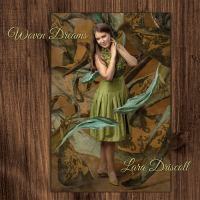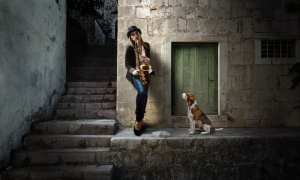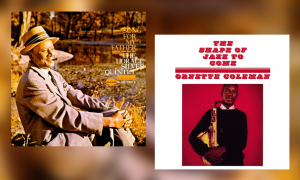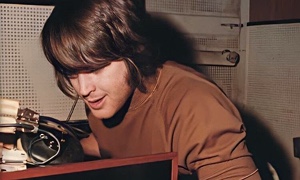Home » Jazz Articles » Building a Jazz Library » Riverside Records: An Alternative Top Ten
Riverside Records: An Alternative Top Ten

In the 1950s, there was a tremendous number of people who were fans, where if they said they were a producer, there was nobody to say, 'No, you're not.' If I'm one of the owners of a company and I decide I'm a jazz producer, who's going to tell me I'm wrong?
—Orrin Keepnews
Orrin Keepnews co-founded Riverside with Bill Grauer. The pair had been colleagues on Grauer's Record Changer magazine, on which Keepnews was the copy editor. At Riverside, Grauer did a little studio work but mostly looked after administration and distribution, leaving Keepnews to concentrate on what he did best, which was scouting for artists and producing records. Grauer passed in late 1963 and Keepnews filed Riverside for voluntary bankruptcy less than a year later. He continued to work as a producer for other labels, most prolifically for Milestone and Fantasy.
In 2007, in his general introduction to the Keepnews Collection reissue series, Keepnews wrote: "For more than a half-century, I have frequently succeeded in finding, recognizing, coddling, arguing with, and collaborating with a great variety of talented and occasionally difficult people. On the whole, I am unreasonably and unshakably proud of the results." So he should have been.
Everyone has their own favourite Riverside albums, but the following would figure on most lists: Thelonious Monk's Brilliant Corners (1957) and others among the dozen-plus masterpieces Monk recorded for Riverside from 1955—1961, Sonny Rollins' The Freedom Suite (1958), Cannonball Adderley's Things Are Getting Better (1959), Nat Adderley's Work Song (1960), Wes Montgomery's The Incredible Jazz Guitar of Wes Montgomery (1960), and Bill Evans' Waltz For Debby (1962) or any other of the four albums Evans recorded with Scott LaFaro and Paul Motian for Riverside from 1959—1961.
This alternative top ten tries to avoid the most widely celebrated Riverside releases and to draw attention instead to some of the label's lesser known treasures.
RIVERSIDE RECORDS: STREAMS & TRIBUTARIES
 Randy Weston Trio
Randy Weston TrioJazz A La Bohemia
1957
Jazz A La Bohemia was recorded live at Greenwich Village's Café Bohemia in 1956. It is the second Riverside album Randy Weston made with Cecil Payne, bop's premier baritone saxophonist and Weston's neighbour in Brooklyn. The disc predates Weston's study trips to Africa, and his formative influence Thelonious Monk still resonates strongly, but you can already hear the Africanisms that would define Weston's style from the 1960s onwards. This is most obvious on "Hold 'Em Joe," a calypso that had been made popular by Harry Belafonte. (Orrin Keepnews was receptive to recording jazz with pronounced African and/or Middle Eastern flavours and two such albums are included in this top ten).
Jazz A La Bohemia also predates Weston's emergence as an artist who mainly recorded his own material. His only original on the album is the Monkish "Chessman's Delight." Keepnews preferred to record Weston on standards—his label debut was Cole Porter In A Modern Mood in 1954. This is forgivable, because Weston's interpretations of the Great American Songbook, like Monk's, are fresh, inventive and of immense charm. In 1959, however, Weston would release the all-original Little Niles (United Artists) and quirky covers became fewer and further between. Happily, Riverside had preserved some of them for posterity.
 Gigi Gryce
Gigi GryceGigi Gryce And The Jazz Lab Quintet
1957
If Gigi Gryce had not early on switched from performing music to teaching it, he might conceivably have gone on to build a profile comparable with that of another great composer and arranger, Charles Mingus: he had a talent which approached Mingus' (though a more affable nature, not always an advantage in career terms). An alto saxophonist and flautist of note, Gryce studied composition at Boston Conservatory and in Paris in the late 1940s and early 1950s. On returning to the US he worked with Thelonious Monk, Howard McGhee, Max Roach and Clifford Brown before setting up The Jazz Lab in 1955.
On Gigi Gryce And The Jazz Lab Quintet, Gryce shares the frontline and writing credits with Donald Byrd, who is billed as co-leader on other albums by the band. The material is split between standards and originals and includes one of Gryce's most enduring tunes, "Minority."
Gryce pushed the boundaries of bop and hard bop, and his work still engages in 2020. He was also a champion of musicians' rights, setting up his own publishing company, Melotone, in 1955, an unusual move for a jazz musician at that time. In the early 1960s, disenchanted with the music business, he moved into teaching.
 Herbie Mann
Herbie MannSultry Serenade
1957
Do not be fooled by the cheesy sleeve art. Sultry Serenade is indeed as sensual as its cover suggests, but it is more than a make-out album. Mann plays flute, alto flute and bass clarinet and leads an imaginatively assembled piano-less sextet which includes baritone saxophonist and second bass clarinetist Jack Nimitz, trombonist Urbie Green, guitarist Joe Puma and bassist Oscar Pettiford. Four of the tunes are Great American Songbook covers, three are originals (one each from Mann, Puma and Pettiford) and the eighth is Tyree Glenn's title track. Mann's arrangements are as rewarding as those on well-realised contemporaneous chamber-jazz albums such as Chico Hamilton's Chico Hamilton Quintet (Pacific Jazz, 1955).
In 2020, Mann is best remembered for fusion albums across a range of genres—among them Flautista! Herbie Mann Plays Afro-Cuban Jazz (Verve, 1959), the unfortunately titled Gone Native (Savoy, 1961), and Do The Bossa Nova (Atlantic 1962)—and also for the soul-jazz infused Memphis Underground (Atlantic, 1969). At their best, Mann's albums combine innovation with accessibility. Sultry Serenade scores on both counts.
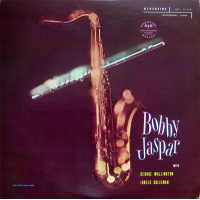 Bobby Jaspar
Bobby JasparTenor And Flute
1957
Like his British contemporary Tubby Hayes, Belgium's Bobby Jaspar was that rare creature during the late 1950s and 1960s: a European jazz musician who was taken seriously by American musicians. After backing visiting stars such as Chet Baker and Jimmy Raney in Brussels and Paris, and a brief marriage to Blossom Dearie, Jaspar moved to New York in 1956, where he worked with Miles Davis, J.J. Johnson, Milt Jackson and Bill Evans.
Tenor And Flute finds Jaspar in great company, leading a band which includes George Wallington and Elvin Jones and, on two tracks, Idrees Sulieman. The material is a mixture of standards and originals by Jasper, Wallington and Sulieman. Jaspar's Lester Young-derived tenor sound, which took on a harder edge a year or so later, shines on four tracks and his flute on the remaining two.
In their search for authentic jazz feeling, several prominent European musicians of the era, including Jaspar and Tubby Hayes, became involved with heroin, the drug of choice of so many of their American idols. Jaspar and Hayes both died of heroin-related causes while still in their thirties.
 Ahmed Abdul Malik
Ahmed Abdul MalikJazz Sahara
1958
Like Yusef Lateef (see below) and Randy Weston, on whose Jazz A La Bohemia he plays, oud player and bassist Ahmed Abdul-Malik was among the first American musicians to (re)introduce shape-shifting infusions of African music to jazz. Also like Lateef and Weston, he embraced Maghrebi and Arabic traditions. Jazz Sahara was Abdul-Malik's first release under his own name.
The album is subtitled Middle-Eastern Music With Johnny Griffin. Johnny Griffin, who recorded frequently for Riverside in the late 1950s and early 1960s, does not play on all tracks and the focus is on Abdul-Malik's oud, bass, composing and arranging. The Middle Eastern flavour is enhanced by a violinist and three hand drummers. Despite lacking any track record in Middle Eastern music, Griffin drops into the modal frameworks convincingly. (In 1957, the adaptable and unflappable Griffin is said to have been an effective last-minute dep for John Coltrane in Thelonious Monk's quartet at NYC's Five Spot, in a band in which Abdul-Malik often replaced the incapacitated-by-heroin Wilbur Ware).
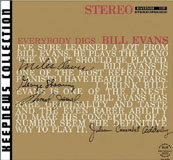 Bill Evans
Bill EvansEverybody Digs Bill Evans
1959
OK, this is a bit of a cheat, as the album is likely to be in the library of every serious Bill Evans enthusiast and so barely qualifies as an "alternative" selection. But Everybody Digs Bill Evans is too often overlooked in favour of the four Riverside albums Evans went on to record with Scott LaFaro and Paul Motian, of which the aforementioned Waltz For Debby is probably the most popular choice.
Like most Evans connoisseurs, Keepnews felt that the albums with LaFaro and Motian caught Evans at the peak of his artistry, the seraphic beauty of his playing ramped up by the intensity of interplay within the trio. Nonetheless, in his liner notes for the 2007 reissue of Everybody Digs Bill Evans, Keepnews wrote: "This might just possibly be my favorite Bill Evans album." The reason is the presence of Philly Joe Jones. On the occasions Jones recorded with Evans, Jones' joie de vivre seemed to liberate Evans, bringing out a looser, less introspective performance which has its own special delights. Check out the trio's reading of Gigi Gryce's "Minority" on the YouTube clip below.
 Yusef Lateef
Yusef LateefThe Centaur And The Phoenix
1960
The Centaur And The Phoenix was recorded a full year before Yusef Lateef's better known Eastern Sounds (Moodsville, 1961). It is a grittier and more satisfying affair than the later disc, which was originally released on Prestige's easy listening imprint, Moodsville. Orrin Keepnews did not put pressure on Lateef to make his music more "acceptable" to American audiences (or if he did, he did not succeed), as Prestige's Bob Weinstock appears to have done.
The lineup on The Centaur And The Phoenix is larger and more adventurous than on Eastern Sounds. Lateef, who plays flute, oboe and tenor saxophone, leads a nonet which includes Tate Houston on baritone saxophone, Josea Taylor on bassoon, Curtis Fuller on trombone, Clark Terry on trumpet and Joe Zawinul on piano. There are three Lateef originals and two pieces by contemporary-classical composer Charles Mills, who was commissioned to rearrange them for the session. An ambitious album and among the best in Lateef's considerable catalogue.
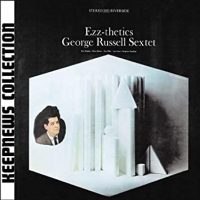 George Russell
George RussellEzz-thetics
1961
Pianist and composer George Russell's book The Lydian Chromatic Concept Of Tonal Organization, published in 1953, is widely recognised as being a trigger for the modal experiments of John Coltrane, Miles Davis and others later in decade. Russell's intent was to liberate improvisation from the constraints of linear chord progressions by, in effect, replacing them with open-ended scales, the basis of traditional African, Arabic, Indian and South East Asian musics. In 2020, Russell is a marginal figure, his name known to jazz connoisseurs but his music rarely listened to.
Ezz-thetics is one of several influential albums recorded by Russell in the late 1950s and early 1960s (another is Stratusphunk, released on Riverside in 1960). Here he leads a sextet which includes Eric Dolphy on alto saxophone and bass clarinet and Dave Baker on trombone. Three of the six tracks were written by Russell, and the rest by Baker, Miles Davis ("Nardis") and Thelonious Monk ('"Round Midnight.") The title of Russell's book might look a bit daunting but his music is wonderfully accessible.
 Mark Murphy
Mark MurphyRah
1961
Other than on its short-lived Living Legends series, which focused on veteran jazz and blues artists, Riverside did not release much vocal jazz. But when it did, Orrin Keepnews was right on the money. Opinions may be divided about Chet Baker as a trumpeter, but as a ballad singer few would deny his talent. Abbey Lincoln's Riverside albums are worthwhile, too. But perhaps the greatest singer Keepnews worked with was Mark Murphy. Murphy could swing hard enough to raise the dead, his jazz sensibility was acute and he was a compelling improviser at all tempos.
Rah seems to have been made with some sort of socio-political concept in mind: Murphy has a book about economics on his knee and is holding a placard. But if there is such a concept, it is as enigmatic as the message on the placard. The message of the album is purely musical. The twelve-track set list is a treasure trove of jazz standards and Great American Songbook covers—"Green Dolphin Street," "Spring Can Really Hang You Up The Most," "Milestones," "Doodlin,'" "My Favorite Things," the evergreens go on. Outstanding, too, are Ernie Wilkins' arrangements and the musicians assembled to play them—among them Melba Liston, Jimmy Cleveland, Blue Mitchell, Clark Terry, Bill Evans and Jimmy Cobb.
 Art Blakey
Art BlakeyUgetsu
1963
Among the last tranche of albums to be released by Riverside, Ugetsu has been unfairly overshadowed by Art Blakey's iconic (for once the word is justified) albums for Blue Note. Blakey leads a six-piece version of the The Jazz Messengers which features a killer three-horn frontline comprising Wayne Shorter, Freddie Hubbard and Curtis Fuller. The same lineup recorded the studio album Caravan (Riverside, 1963), but this live set has the edge. As swansongs go, Riverside could barely have gone out with a bigger bang.
Photo: Orrin Keepnews with (seated l-r) Scott LaFaro, Bill Evans and Paul Motian at the Village Vanguard, 1961.
Tags
PREVIOUS / NEXT
Support All About Jazz
 All About Jazz has been a pillar of jazz since 1995, championing it as an art form and, more importantly, supporting the musicians who make it. Our enduring commitment has made "AAJ" one of the most culturally important websites of its kind, read by hundreds of thousands of fans, musicians and industry figures every month.
All About Jazz has been a pillar of jazz since 1995, championing it as an art form and, more importantly, supporting the musicians who make it. Our enduring commitment has made "AAJ" one of the most culturally important websites of its kind, read by hundreds of thousands of fans, musicians and industry figures every month.


